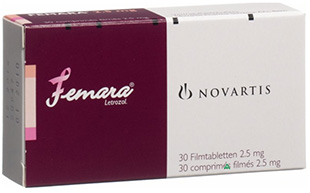Medication Overview: Femara
Femara, known generically as letrozole, is a medication used primarily for the treatment of certain types of breast cancer in postmenopausal women. It is classified as an aromatase inhibitor and functions by decreasing the amount of estrogen the body makes, slowing or reversing the growth of estrogen-sensitive tumor cells. Femara is usually taken orally in tablet form, once daily, with or without food. It is important for patients to adhere strictly to their prescribed dosage and schedule.
Indications and Usage
This medication is specifically indicated for the adjuvant treatment of hormone receptor-positive early breast cancer in postmenopausal women. Femara is also used in extended adjuvant treatment of early breast cancer in the same demographic who have received prior standard adjuvant treatment with tamoxifen. Additionally, it is indicated for the treatment of advanced breast cancer in postmenopausal women with disease progression following anti-estrogen therapy. It is not effective in patients with ER-negative disease and premenopausal women.
Pharmacodynamics and Mechanism
Femara targets and inhibits the aromatase enzyme, which is involved in estrogen production. By binding to the aromatase enzyme, letrozole causes a significant reduction in serum estrogen levels. This decrease subsequently lowers the level of estrogen available to stimulate the growth of estrogen-dependent breast cancer cells. Its mechanism is highly selective and targets peripheral aromatization, substantially reducing circulating estrogen concentrations.
Recommended Dosage Administration
The standard recommended dosage of Femara is 2.5 mg once daily. Treatment duration can vary, typically continuing until tumor progression is evident for metastatic breast cancer, or up to 5 years for adjuvant settings. In cases of renal or hepatic impairment, dose adjustments are not usually required, but close monitoring is recommended. Patients should take it consistently at the same time each day to maintain steady plasma levels.
Common Side Effects
Femara treatment may result in several common side effects. These include, but are not limited to, hot flashes, night sweats, and fatigue. Patients may also experience increased cholesterol levels, weight gain, and musculoskeletal symptoms such as joint pain or stiffness. Mood disturbances and headaches are similarly reported. Patients should be encouraged to report any persistent or bothersome side effects to their healthcare provider.
Less Common Adverse Events
Less frequently, patients taking Femara may experience more serious side effects. These may include osteoporosis due to decreased bone mineral density, hepatic function disorders, and significant cardiovascular events. Vision changes and severe allergic reactions, although rare, can occur and necessitate immediate medical attention. Continuous evaluation of risk versus benefit is essential in long-term use scenarios.
Drug Interactions Overview
Femara has the potential to interact with other medications, influencing its effectiveness or increasing possible side effects. Caution should be exercised when used concurrently with drugs such as tamoxifen, which can diminish the effectiveness of letrozole. Other potential interactions may arise with estrogen-containing drugs, which could counteract the therapeutic effects of Femara by increasing serum estrogen levels.
Storage and Stability
Femara tablets should be stored at room temperature, away from moisture and light. They should be kept in their original packaging and dispensed in tight, light-resistant containers. Patients should be advised to keep this medication out of reach of children and to dispose of unused or expired tablets according to local regulations for pharmaceutical waste.
Pharmacokinetics Details
Letrozole exhibits a rapid absorption profile with peak plasma concentrations typically occurring within two hours post-dose. It possesses a high bioavailability, independent of food intake. The drug is extensively metabolized in the liver, primarily through the CYP3A4 and CYP2A6 pathways, and eliminated primarily as metabolites via the renal route. The elimination half-life is about 2 days, facilitating steady-state concentrations with continuous daily dosing.
Patient Monitoring Recommendations
Patients on Femara therapy should undergo regular monitoring to assess treatment efficacy and manage potential adverse effects. Bone mineral density assessments are recommended due to the risk of osteoporosis. Periodic liver function tests and lipid profiles may be considered to detect any hepatic dysfunction or hyperlipidemia early. Monitoring should be tailored based on individual patient risk factors and treatment response.








Reviews
There are no reviews yet.